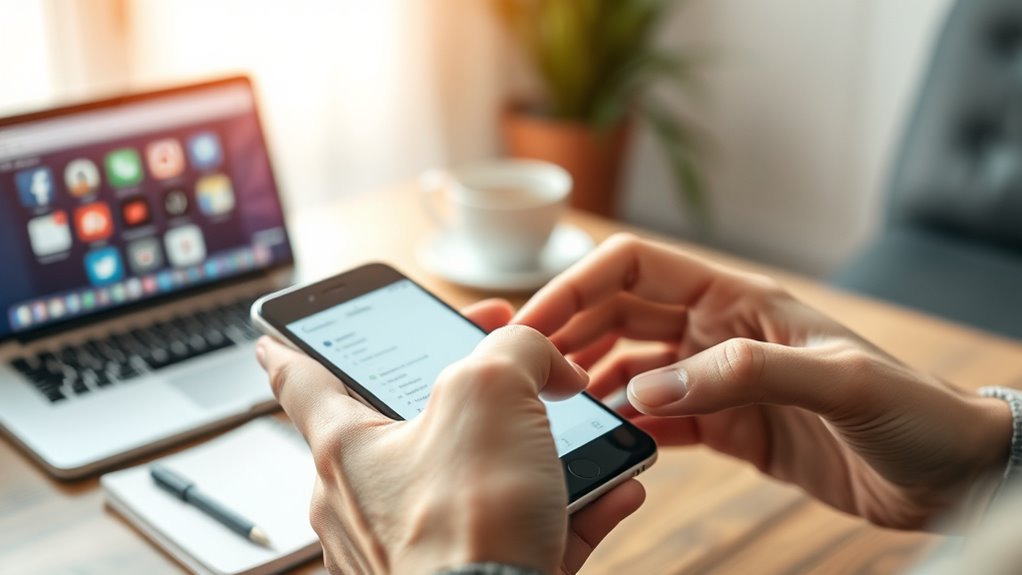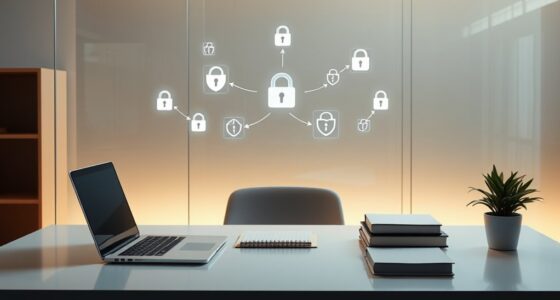To protect your privacy on social media, start by adjusting your privacy settings to control who can see your profile and posts. Be mindful of how much personal information you share, avoiding details like your full address or location updates. Use strong, unique passwords and enable two-factor authentication for extra security. Regularly review connected apps and revoke access to untrusted ones. Keep these tips in mind, and you’ll learn more ways to keep your online presence secure.
Key Takeaways
- Adjust your profile visibility settings to “Friends only” or “Private” to limit access.
- Be cautious about sharing personal details like your full name, address, or location updates.
- Use strong, unique passwords and enable two-factor authentication for added security.
- Regularly review and disconnect untrusted third-party apps linked to your social media accounts.
- Stay informed about platform privacy policies and update your privacy settings accordingly.
Adjust Your Privacy Settings

Have you ever wondered who can see your social media posts? Many fall for privacy myths, thinking their profile visibility is automatically secure. The truth is, your settings control who views your content. By adjusting your privacy settings, you can limit access to your posts, photos, and personal details. Don’t assume your account is private just because it looks that way; check your profile visibility options regularly. Set your profiles to “Friends only” or “Private” to prevent strangers from viewing your information. Remember, social media platforms often change their privacy policies, so stay informed and update settings as needed. Taking control of your privacy settings guarantees you’re not exposing more than you intend, helping you protect your personal space online. Additionally, understanding the importance of trustworthiness of online profiles can help you make informed choices about what information to share.
Be Mindful of Sharing Personal Information

Are you aware of how much personal information you reveal when sharing on social media? Oversharing can compromise your privacy and security. Be cautious about posting personal details like your full name, address, or phone number. Sharing location updates frequently can also expose your whereabouts to strangers. To protect yourself, consider these tips:
- Limit sharing your current location to trusted contacts only.
- Avoid posting detailed personal information that can identify you offline.
- Think twice before sharing your travel plans or daily routines publicly.
- Review your privacy settings regularly to control who sees your posts.
- Be mindful of the privacy settings available on social platforms to enhance your data protection.
Use Strong and Unique Passwords
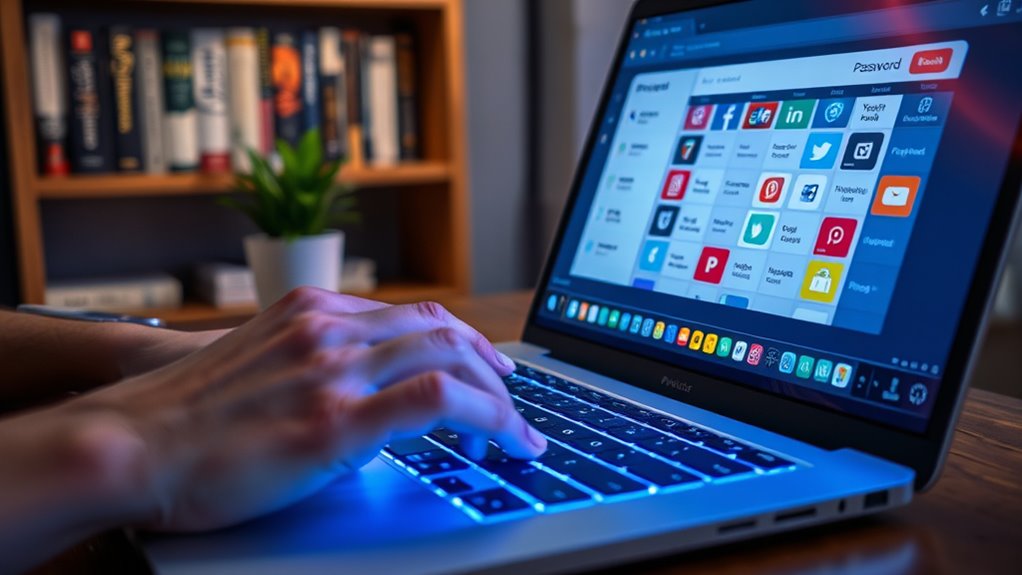
Using strong and unique passwords is essential to safeguard your social media accounts from unauthorized access. Avoid using the same password across multiple platforms, as this puts all your accounts at risk if one gets compromised. Instead, create unique passphrases that are difficult to guess, combining random words or a mix of letters, numbers, and symbols. To manage these complex passwords efficiently, consider using a password manager; it securely stores and autofills your login details, so you don’t have to remember each one. Regularly updating your passwords also enhances your security. Incorporating top mattress toppers can significantly improve your sleep quality, which supports overall mental and emotional well-being. By taking these steps, you make it markedly harder for hackers to gain access to your social media profiles, protecting your personal information from malicious actors.
Enable Two-Factor Authentication
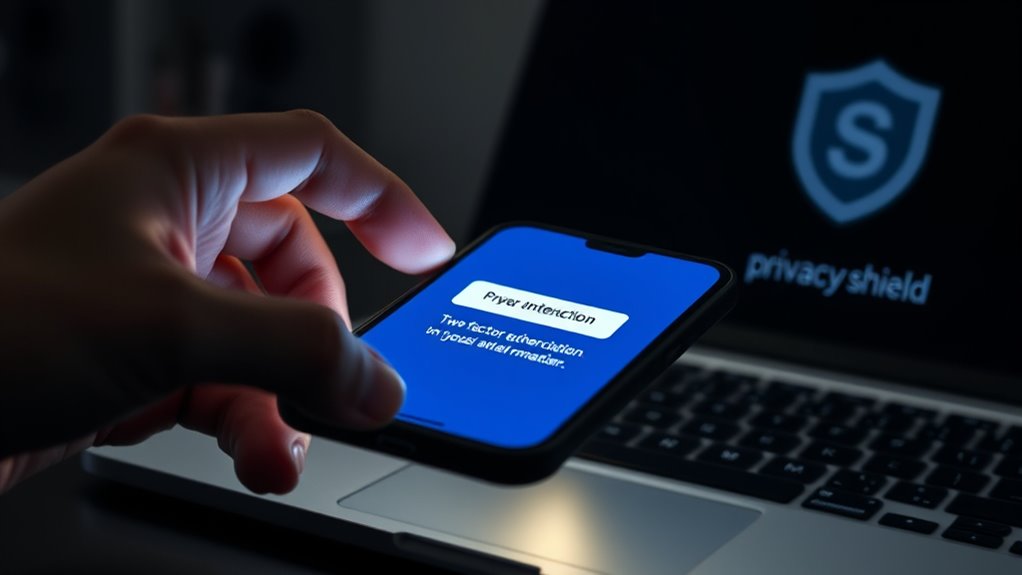
Building on the importance of strong, unique passwords, enabling two-factor authentication (2FA) adds an extra layer of security to your social media accounts. By activating 2FA, you markedly enhance your account security, making it harder for hackers to gain access. Here’s how to do it:
- Navigate to your account settings and locate security options.
- Select “Two-Factor Authentication” or “2FA.”
- Choose your preferred method—authenticator app or SMS codes.
- Follow prompts to verify your identity and activate 2FA.
- Remember that user privacy is further protected when you enable 2FA, as it adds an additional verification step to prevent unauthorized access.
Implementing two factor authentication ensures that even if your password is compromised, an additional verification step protects your account from unauthorized access. It’s a simple yet effective way to safeguard your privacy online.
Regularly Review and Manage Your Connected Apps
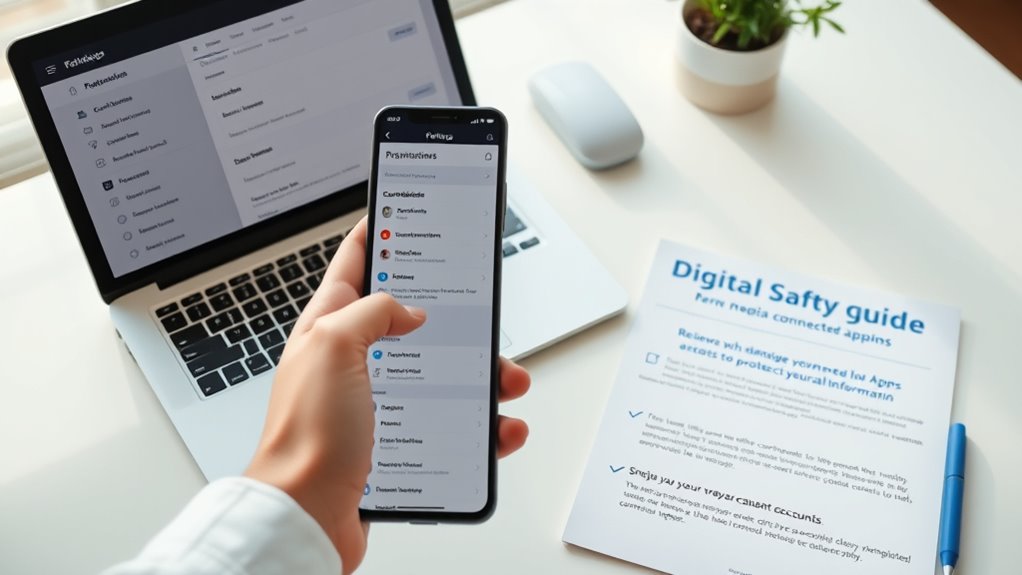
Have you ever checked which apps and services are connected to your social media accounts? Regularly reviewing and managing your connected apps is vital for protecting your privacy. App permissions often grant third-party access to your profile, posts, and personal data, which can pose security risks if left unchecked. By auditing these permissions, you can revoke access for apps you no longer use or trust. This reduces the chance of unwanted data sharing or misuse. Most social media platforms have settings to view and manage connected apps easily. Making this a routine habit ensures you stay in control of your digital footprint and maintain your privacy. Stay proactive by keeping only trusted apps connected, and remove any that seem suspicious or unnecessary. Regularly reviewing app permissions helps prevent potential privacy breaches and keeps your information secure.
Frequently Asked Questions
How Can I Recognize Fake or Malicious Accounts?
When you’re trying to recognize fake or malicious accounts, look for signs like incomplete profiles, generic photos, or inconsistent information. Check for profile verification badges, which indicate authenticity. Watch out for suspicious activity, such as messages asking for personal info or links to untrusted sites. By paying attention to these clues, you can better identify fake accounts and stay safer online.
What Are the Signs My Account Has Been Hacked?
When your account starts acting up, it’s a red flag you might be in hot water. You could notice suspicious activity, like messages you didn’t send, or your settings changing unexpectedly. Password breaches often lead to unauthorized access, so changing your password immediately is key. Keep an eye on login alerts and unusual activity—these signs tell you your account’s been hacked, and it’s time to act fast to secure it.
How Do I Delete or Deactivate My Social Media Accounts?
To delete or deactivate your social media accounts, first log in and explore the privacy settings. If you want to deactivate temporarily, find the deactivate option and follow the prompts. For a permanent delete, look for account verification steps, which may involve confirming your password or email. Be sure to back up any important data before proceeding, and follow the platform’s instructions carefully to guarantee your account is fully removed or deactivated.
Can I Recover Deleted Posts or Messages?
Think of your deleted posts and messages as fallen leaves—you might wish to gather them back. Once you delete content, recovery depends on the platform’s policies; some allow data backups or archive requests, while others don’t. Check your privacy settings and download your data backup regularly to keep important info safe. Remember, acting quickly improves your chances, but always review platform-specific guidelines for the best shot at recovery.
How Do I Report Privacy Violations or Harassment?
When you face privacy violations or harassment, you should start by reviewing your privacy settings to limit exposure. Then, follow the platform’s reporting procedures, which typically involve flagging the offending content or user. Be specific about the violation, provide evidence if needed, and report it promptly. This proactive approach helps platform moderators address the issue and keeps your online experience safer and more private.
Conclusion
By taking these simple steps, you’ll find that your online privacy naturally improves—almost like a coincidence. As you adjust your settings, choose strong passwords, and stay aware of what you share, you’ll notice a sense of control and peace of mind. Sometimes, protecting your privacy becomes effortless when you make small, deliberate choices. It’s funny how a little bit of effort can lead to a much safer social media experience—almost as if luck is on your side.
